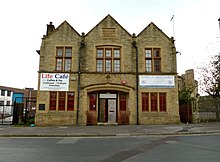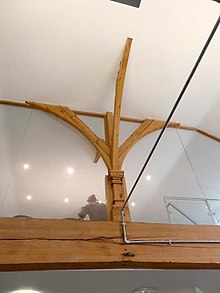St Mark's Church, Huddersfield
There had been bad weather during the previous week, and the ceremony was performed before a "considerable" crowd under a large tent in a high wind, although the rain had abated.
The blade was engraved thus:[1] "Presented to Mrs William Brooke, on the occasion of her laying the foundation stone of St Mark's Church, Leeds-Road, Huddersfield, Saturday May 15th, 1886, by W. Swinden Barber, architect, James W. Bardsley, vicar of Huddersfield and chairman of the Building Committee; Edward Armitage, treasurer; and George Fisher, secretary.
Heading the list of surpliced clerics were the Reverends J. Wareing Bardsley MA vicar and Rural Dean of Huddersfield, and John Dunbar, vicar-designate of St Mark's, and the choir led by Mr Fowles.
Richards, headmaster of Huddersfield College, three justices of the peace, a number of local personages and the building contractors.
[8] This was the reason why the parish had been split, and St Mark's built as an extra church, on land given by Sir John Ramsden.
[1] The building was consecrated in front of a large congregation at 10.30 am on Tuesday 27 September 1887, by William Boyd Carpenter, Bishop of Ripon.
The bishop "was accompanied by the majority of the clergy [all surpliced] in the rural deanery, and a procession was formed proceeding up the middle aisle of the church to the chancel."
The congregation joined in with the hymns Christ is our corner stone, We love the place, O God, and Pour out thy spirit from on high.
[9] The Huddersfield Chronicle described "an excellent and substantial luncheon" which the vicar had arranged in the Parish Church Schools, and which were very well attended by clergy and laity, and evidently at least one journalist.
Bardsey said that the estimated cost of the building was at that time £4,024, and that they had raised subscriptions totalling more than £5,430, including money from some very poor local people.
He listed a number of gifts, including vestry furniture and communion plate, showing that this church was fully furnished on consecration day.
Barber the architect was toasted, and replied that "the church was extremely plain and might be much improved by colouring and stained glass, but he supposed such matters must be left open for future consideration."
[9] Due to its proximity with Huddersfield Broad Canal, the foundations of the east wall were deep and made of concrete.
[9] The Huddersfield Chronicle described the 1886 plans for the interior thus:[1] "Internally the roofs and chancel arch are somewhat striking, owing to the wide span and heavy timbers which will be used, but all details such as the windows and open benches are very plainly drawn.
[11] The east window will be of three long lancet lights, ad here is an opportunity for a display of stained glass, which would be a decoration of great value to the interior of the building.
Messrs B. Graham and Nephew of Mold Green, Kirkheaton contracted for the excavators, masons, carpenters and joiners' work.
[1] The internal wooden roofs of nave and chancel were described in 1887 as "waggon-headed"; that is to say that the ceiling above the trusses was in the form of a round arch like the cover of a wagon.
On 18 September 2001 all covenants were removed and it was sold to Church property holdings Limited which conserved the interior stone carvings and the major roof timbers, and divided the building into offices.
His mother was Susan Smith (born 1819 in Bolton), working in the manufacture of buckets and hose in the same year, when they were living at 26 Blair Street, Toxteth Park, Liverpool.
[16][17] The 1871 Census finds the family at the same address, with only two of John's siblings present: a pupil teacher and an apprentice watchmaker.
He said that Dunbar preached "thorough, simple, faithful, gospel sermons, was a first rate parish priest, understood something of the feeling of the brotherhood of man, gave a good grip of the hand, and had a habit of getting round people in a very remarkable way.
"[9] Dunbar was vicar of St Mark, Leeds Road from Wednesday 21 December 1887 to November 1888,[23][24] being licensed to the post by the Bishop of Ripon.
[23][24][27] Annie died, possibly in childbirth, around February 1891,[22] so the 5–6 April 1891 Census finds John as a widower and vicar of Rashcliffe, with three children: Dean (b.1885), Leslie (b.1888), and Ursula (b.1891) aged 2 months.
[28] In 1901 he was 44, still living at St Stephen's vicarage in Victoria Road, Rashcliffe, Huddersfield, with the children now aged ten to sixteen, and two sisters-in-law with surname Dean.
[33] Canon Percy Holbrook MA (1859–1946): He was born in Reading, Berkshire, England, the son of a silk mercer or draper.
[64] Reverend Robert Alfred Humble BA (1864–1929) was an Anglican priest, born in Heathery Cleugh, Weardale, Durham, England.
He contributed to the work of committees, and joined in local social events, being a member of his church's cricket team.
It is in this context of sociability and regular work among his congregation that the events surrounding the delayed discovery of his death, mentioned in several newspapers, remain a puzzle.
Having suffered a seizure, he apparently lay openly on a flower bed in his vicarage garden on a dark February night, while his congregation spent eleven hours searching for him on the adjacent moorland.
"[3][27][86] Reverend Joseph Miller BD (b.1874) was a Congregational minister, much in demand as an "eloquent preacher" for fourteen years in the north of England.








